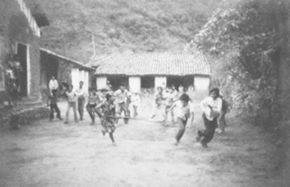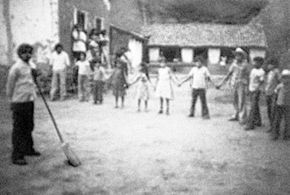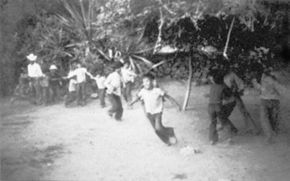Hesperian Health Guides
How do germs make holes in the teeth?
HealthWiki > Where There Is No Dentist > Chapter 4: School Activities for Learning about Teeth and Gums > How do germs make holes in the teeth?
THE IDEA:
Acid makes holes in the teeth. The acid is made when sweet foods mix with germs in your mouth.
It is not possible to prevent cavities or gum problems by trying to kill all of the germs in your mouth. There are too many — and some germs are good for you. The important thing is to keep the germs from getting together and making a film or coating on your teeth.
This film on the teeth is called plaque, but you do not need to use this word. Every morning we can all feel a “furry” film on our teeth. This film must not be allowed to stay on the teeth because it will mix with sugar and make acid. Worse, if it stays in a group (called a “colony”) for more than 24 hours, it will mix with saliva, harden, and make tartar.
The main reason for cleaning teeth is to break up these colonies so they cannot make acid. Also, if you forget to clean your teeth, tartar will form, and you will need a dental worker to scrape it off. This is why it is important to clean your teeth at least every 24 hours, so the tartar can never form on your teeth.
THE ACTIVITY:
Here is a game called “Brush it!” that students can play outside. You can adapt it to the needs of your class, including the number of children and “teeth,” the distances involved, and any disability challenges your students may have. You need:

- Five “teeth” (a tree, rock, or the corner of a house can be a base) in a half circle, 12 meters apart. Each tooth must have a “Monitor” who stays at the tooth.
- One person with a broom. This person is the “Brusher.”
The Game:
The students who are not Monitors or the Brusher are the “Germs,” and they stand facing the Brusher. When the Brusher says “Go!” the Germs try to form colonies around the teeth before the Brusher can touch them with the broom.
 |
| The Brusher (on left,with broom) has lost the game. The children behind him have formed a “colony.” |
 |
| Here the Brusher stops a boy from completing a chain. |
The Germs win if they make a colony. There are two ways to do this: (1) 15 Germs touching one Monitor at a tooth, or (2) a chain of 12 Germs holding hands, touching two Monitors.
Play two games: one with children trying to form the first kind of colony, one with the second kind. These photos are from the second game.
The Brusher tries to stop the others by touching them with the broom. When the Brusher touches a Germ with the broom, that child must step out of the game for one minute.
The Brusher wins if no colonies form in 5 minutes.
The decolonizer wins if no colonies form in 5 minutes.

to see!
After The Game:
Talk to the students about germs in their mouths and how small they are. Can anyone see germs? No, but they can feel them and taste them. Ask the group what their mouths feel like in the morning when they wake up. You may get these answers:
- My teeth feel mossy.
- My breath is bad.
- I feel a coating on my teeth, but it goes away when I brush them.
Tell the students that this coating on the teeth is a colony of germs. They are always trying to group together on the teeth or in spaces between the teeth — just as the Germs did in the game! But brushing their teeth helps prevent this, just like the Brusher prevented the Germs from forming colonies in the game.


